Installing Windows 7 on the EEE-PC 1000HE

I thought about buying a netbook for a long time. Ideas have wandered since last year, but now they’re around. The main reason for the purchase is that the netbook fits in the rear case of the motorcycle, which eliminates the need to carry a backpack with a full-sized laptop. After a long market research, my choice fell on ASUS EEE 1000HE. Atom N280, keyboard a la Apple, a battery for 8 hours and a case and a cloth in the kit outweighed the arguments of competitors.
The netbook comes with the Czech version of Windows XP, which is unacceptable for me. Although, I know people who find it funny and even convenient. In this post I will describe the procedure for installing Windows 7 on my netbook. Immediately, I’ll emphasize that I need Windows to work. So let's go.
- Download the Windows7 distribution from the official website in iso format. There you can add keys. I downloaded the 32-bit version. 64-bit on my netbook is not needed.
- Update the netbook's BIOS to the latest version using the supplied ASUS Update utility.
') - Prepare a flash drive (at least 4Gb). Desirable empty.
- Now you need to rewrite the contents of the iso image on the flash drive in any way. I used DaemonTools, the happy owner of which I am. Who does not have, you can download the full-featured traial here . With the help of DaemonTools, I zamapil image on a virtual drive and copied its contents to a flash drive. Attention! Before copying, you need to make sure that you have the option to display hidden and system files in Windows Explorer. For those who do not like DaemonTools can simply burn the image to disk using any program that knows how to do it, for example Nero Burning Rom and transfer files to the flash drive already from the disk. For the rest, you can use WinRAR, which also can open iso-images.
- If Windows XP is already installed on the netbook and there is a free partition on which you want to install Windows 7, then there is no need to make a bootable flash drive. Just insert it into your netbook and run the installer. In this case, the next item can be skipped. My situation was exactly that. My EEE had a Czech XP onboard and a free 60GB partition, where I installed Windows 7. Now I have a double boot.
- If you have Linux or you need to shuffle partitions on the disk, then you need a bootable flash drive. For this, I recommend using LiveUSBHelper. Download and install it from here . If the program requires vb6stkit.dll when it starts, you can download it here . I still needed to install a set of activeX components from Microsoft, which can be downloaded from the Microsoft website. The program itself will tell where. The interface is intuitive, I will not describe the details.
- Run the Windows 7 installer. To do this, either boot from the flash drive or run it from XP. Attention, to boot from a flash drive, you need to change the priority of boot devices in BIOS. Although, I already had a boot from the flash drive over the default boot from the disk. There were no problems with the installation. Questions Wind now asks less and all IMHO easier. The installation took about half an hour or forty minutes.
- Almost all drivers are already in the distribution. For normal operation of hardware buttons, you need to install the ACPI driver from ASUSa. And ASUS Instant Key Utility. Download it all from here . They don't have versions for Vista and for Win7, but my XP drivers worked fine for me. One feature. Do not run AsusSetup.exe. He swears at the Windows version. There is another installer in the same directory. For ACPI drivers, this is Setup.exe, for Instant key Utility, this is EEEInstantKey_1.08.exe. Here it is and run in compatibility mode. Everything was fine and working for me.
I had to dig a little over the settings of the wireless network. Winda saw all the wireless networks, but for some reason did not want to connect to mine. At first, I thought there was a problem in WPA2. But Winda refused to join the network even with encryption turned off. As it turned out, the drivers for wi-fi cards are a bit damp and do not normally work with all routers. I have a home network based on Apple Airport in the "Only g" mode. Changing the mode to "Compatible b / g" cured the problem. I hope this problem will be solved by updates. By the way, the update for wi-fi drivers is already available through Windows Update. This problem may have already been fixed.
Now I’ll say a few words about performance. Windows 7 works on this configuration perfectly. Even the transparency of the windows is automatically turned on. I installed a standard set of Java developers, including JDK and Eclipse. Eclipse was installed normally and works quickly. You can work more or less normally by closing the side panels. Slows down a little Android emulator, but not so much that it was impossible to work. The main thing is not to close it after the first launch. :) Heavy J2EE netbook applications, of course, will not pull. If it pulls, the development will turn into hell. But for something light, it is quite normal. In this case, the size and power can be sacrificed for the sake of mobility.
For the Internet, I recommend to put Google Chrome. It works faster than Internet Explorer 8. Although, perhaps this is subjective.
Source: https://habr.com/ru/post/60355/
All Articles